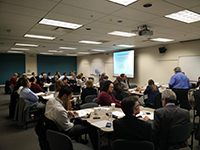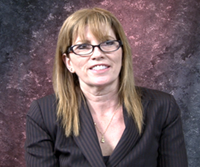
Criminal Justice Realignment Resource Center
CourtStory: Post-Realignment
CourtStory, a news feature of the Criminal Justice Services office (CJS), highlights efforts undertaken by courts, post-realignment. While the stories might feature an individual or a specific court, they are really about how courts are responding to change. Listen to or view the individual stories below.
Friday, May 13, 2016, Veterans Court Conference, Salinas, CA
Last January, Monterey Court started a Veteran Court with a Recidivism Reduction Fund (RRF) Grant. Getting a new court off the ground is a considerable undertaking, requiring commitments from traditional justice partners (i.e., judges, DA, PD, providers and law enforcement). To start a new court and host the first California court-led Veterans Court Symposium in the first year is unprecedented (and, can I say it? a bit crazy). To figure out exactly what was going on in Monterey, I went down to Salinas, CA, to the National Steinbeck Center, where the day-long conference took place, to take it all in.
The registration area had several service providers seated behind tables, eager to tell me about their services. When I finally entered the large conference room, the first thing I had to do was find a seat. The room was already at capacity.
After opening remarks from Presiding Judge Mark E. Hood, keynote speaker Judge Robert Russell, who started the nation’s first Veterans Court in Buffalo, New York, got the conference started with a dynamic, yet, very practical presentation about how his Veterans court started and describing key components of successful Veterans Courts. Next, were presentations on domestic violence, post-traumatic stress and co-occurring disorders and by a panel of community-based service providers. Materials from the symposium can be downloaded here.


A few weeks later, I talked with the court’s Administrative Analyst & Public Information Officer, Nona Medina, and Hon. Sam Lavorato, Jr., Monterey’s Veterans Court judge, to learn why a program just getting started would organize a conference for 200 people. Both were modest about their achievements, sharing the credit with their partners (i.e., Monterey County Bar Association, local service providers and others).
Indeed, I quickly learned that they were not crazy, but hardworking and dedicated. They shared that planning their Veterans Court took years; and, in the process they learned much and wanted to share their knowledge and encourage others to develop such a specialized court*.
I left Monterey inspired by the court’s leadership, vision and level of commitment and feeling a bit inadequate. I really need to be doing more.
* Courts from other counties were in attendance
Highlights from the 2016 Reentry Court Roundtable
“As a case manager, this was great information and very helpful”
“All of the instructors seemed to be experts with regards to their subject matter, which made each presentation valuable”
 On March 30th, 2016, the Judicial Council Criminal Justice Office held the “Reentry Court Roundtablei in San Francisco, which brought together existing and new reentry courts, as well as jurisdictions interested in developing a program. Over 60 judges, attorneys and justice partners attended the day-long program, where, among the topics discussed, were data collection, parole and parole services, accessing services, program funding and the nuts and bolts of starting a program. Below, are highlights from selected “Roundtable” workshops.
On March 30th, 2016, the Judicial Council Criminal Justice Office held the “Reentry Court Roundtablei in San Francisco, which brought together existing and new reentry courts, as well as jurisdictions interested in developing a program. Over 60 judges, attorneys and justice partners attended the day-long program, where, among the topics discussed, were data collection, parole and parole services, accessing services, program funding and the nuts and bolts of starting a program. Below, are highlights from selected “Roundtable” workshops.
The “Accessing and Leveraging Services” workshop, provided information about how some programs might be able to fund mental health and substance abuse treatment services through Medi-Cal and the Affordable Care Act (ACA). If Reentry Courts can leverage ACA/Medi-Cal, then, they might be able to reallocate grant or other funds, otherwise spent on health care services, to support other activities (i.e., education, employment and housing).
As Criminal Justice Services staff learn more about the ACA, health services and qualified providers, they will share that information with Reentry Courts.
Another session, “Nuts and Bolts of Establishing a Reentry Court”, was practical in describing steps for implementing and developing a reentry court program, beginning with gaining buy-in from the presiding judge, engagement of the bar and service providers, developing a program manual, outlining program eligibility and roles for each member of the team.
During lunch, courts held team meetings or joined one of two discussions: creating successful partnerships or developing a regional approach to reentry courts for small rural jurisdictions.
The final session covered how to fund programs and services, where to look for grants and understanding their requirements. While identifying funding opportunities might be considered administrative, panelists emphasized that the entire team needs to be familiar with what goes into grant solicitation and writing.
Finally, evaluations for the program were excellent and many suggested that more time was needed and that, in the future, portions of the program be simulcast. All of the feedback from this program will be incorporated into the 2017 Reentry Court Roundtable.
i - The fifth convening of reentry courts
Los Angeles Superior Court Second Chance Women's Re-Entry Court:
Changing the Lives of Women
 Michael Roosevelt, Senior Court Services Analyst for the Judicial Council of California Criminal Justice Services office, interviews Nancy Richards-Chand, Los Angeles Public Defender, Second Chance Women's Re-Entry Court. "Second Chance" was California's first Reentry Court and remains the only one for women. Modeled after Drug Court, Reentry Court provides an alternative to returning a person to prison or jail for a parole or probation violation.
Michael Roosevelt, Senior Court Services Analyst for the Judicial Council of California Criminal Justice Services office, interviews Nancy Richards-Chand, Los Angeles Public Defender, Second Chance Women's Re-Entry Court. "Second Chance" was California's first Reentry Court and remains the only one for women. Modeled after Drug Court, Reentry Court provides an alternative to returning a person to prison or jail for a parole or probation violation.
Hear Nancy Richards-Chand speak about Second Chance Women's Re-Entry Court ![]()
San Diego Mandatory Supervision Court: A Model for Increasing Public Safety and Reducing Recidivism
San Diego Mandatory Supervision Court is intended to reduce recidivism among offenders serving a "split sentence" on return to the community, thereby increasing public safety Simply stated, a "split sentence" is when an offender serves a portion of a sentence in county jail and the remaining portion in the community.
San Diego Mandatory Supervision Court is a partnership between the San Diego Sheriff Department, the public defender, district attorney, court and probation. Offenders serving a "split sentence" are housed in a special jail facility receive services (i.e., education, anger management, counseling and job readiness/training programs to prepare them for release into the community).
According to Mandatory Supervision Court Judge Desiree Bruce-Lyle, prior to release, probation prepares an offender case plan/pre-release report for the court. To ensure accountability, the public defender, district attorney, probation, the court and a representative from the Sheriff Department agree on the report's recommendations. Upon release, the offender is supervised by probation, required to appear in court to report on their progress and compliance with their probation conditions.
While San Diego's Mandatory Supervision Court is new, Judge Bruce-Lyle, observes, anecdotally, that the program appears to be having the desired impact: reducing recidivism and increasing public safety. Even with early success, challenges remain. One challenge is convincing offenders to choose a "split sentence" over doing the complete jail term. By not agreeing to a "split", they complete the full jail term and avoid supervision by probation and the court. However, data shows when people are released unsupervised back into the community and without services they recidivate at a higher rate than people who are supervised and receiving services.
Judge Bruce–Lyle believes there is a fix for the problem, but she'll leave that to the state legislature.
Judge Bruce–Lyle discusses San Diego's Mandatory Supervision Court.
Court Supervision of Moderate Risk and Need Offenders in Santa Clara
Prior to realignment, Santa Clara Superior Court established California's first Reentry Court concentrating on high risk/high need offenders, who are more likely to reoffend or violate conditions of parole or probation. However, not to overlook moderate risk/moderate need offenders, the court developed a "two-judge panel" to monitor this population. The two judges, who arraign cases, monitor those same offenders for compliance with conditions of parole or probation. If, however, an individual requires more supervision, the offender is referred to the reentry court.
According to Judge Stephen Manley, the "two-judge panel" has improved compliance with parole or probation conditions and reduced recidivism among moderate risk -moderate need offenders. He adds that the success of this approach with moderate risk/moderate need offenders allows the reentry court to accept more high risk/high need offenders (severely mentally ill and sex offenders).
Finally, Judge Stephen Manley believes the model could be replicated with similar reduction in recidivism rates.
Judge Stephen Manley discusses Santa Clara's two-judge panel model:
Ventura's Pretrial Assessment Program
Ventura's Presiding Judge Brian Back discusses their recently instituted Pretrial Assessment Program. Simply stated, pretrial programs use pre-screening and assessment tools pretrial to determine an offender's risk of reoffending and likelihood of appearing in court. While Judge Back would not call the pretrial program innovative, early indications are that it has been successful: freeing up needed jail beds by releasing low-risk offenders, who are more likely to make their court date, and filling beds with high-risk offenders. In a finding consistent with national studies (Pretrial Justice Institute), Ventura's pretrial program has increased the number of people released pretrial-- straight OR (own recognizance) or OR with conditions--without decreasing public safety. According to Judge Back, ninety-five percent of people released pretrial do not reoffend and appear for their court date. ![]()
Judge Back believes the program success is attributable to the collaboration between justice partners—Sheriff, District Attorney, Public Defender, Probation and the court. When agencies work together the public is better served and safer.
Hear Judge Back discuss the Pretrial Assessment Program ![]()
Note: Telephone interview